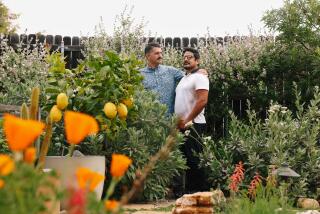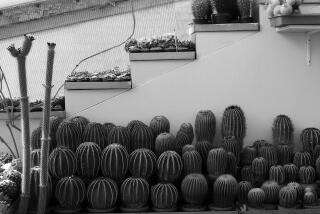With baseball plant, throw a curve into your windowsill garden
In the spirit of the season, meet the baseball plant, sometimes sold as the baseball cactus, so named for the ribs that resemble the stitching on a ball.
For some gardeners, it’s a catch: slow growing, pest resistant, drought tolerant and undemanding -- a tiny, thornless, living sculpture that could be forgotten for months on a windowsill.
Those ribs (often numbering eight, but sometimes more) become more pronounced with age along with the plaid pattern of the skin. Although the plant is sometimes called a cactus, it’s actually a succulent, in the Euphorbia genus (Euphorbia obesa).
The baseball plant has been around for more than a century. A few decades after it was discovered in the eastern cape of South Africa in the late 1800s, the baseball plant was harvested in the wild nearly to extinction. Government regulation protected the plant in the wild, and commercial growers found it was easy to propagate, bringing down the price. But the plant’s populations in the wild have not fully recovered.
The appeal? “It looks like a plant from outer space,” says David Bernstein, owner of California Nursery Specialties in Reseda. “Each plant is unique. Some look like hot air balloons, some look like baseballs.”
The baseball plant provides an introduction to succulents as well as a hands-on lesson in plant sex and pollination. It is dioecious, meaning plants are male or female, so you need one of each. With a fine-tipped brush, transfer the pollen from the male onto the flowers of the female. (The difference will be obvious.)
The fruit emerges like a tiny diamond where the flower had been, developing into a small pod that, when ripe, will burst with explosive force, scattering seed for yards in all directions.
“It sounds like a cap gun,” Bernstein says.
He puts little gauze caps on his plants to catch the harvest; other collectors put the entire plant in a box with a mesh top. There are no more than three seeds per pod, so you don’t want to lose any -- each easy to start as a new plant.
As the plant matures, the baseball starts looking like a football -- more oval than round. The plant likes shade or dappled bright light; it hates being cold or wet.
The Global Garden is our series looking at a world of cultures through the lens of our landscapes. Past installments
JOIN THE CONVERSATION:
@latimeshome | pinterest.com/latimeshome | facebook.com/latimeshome | facebook.com/latimesgarden






